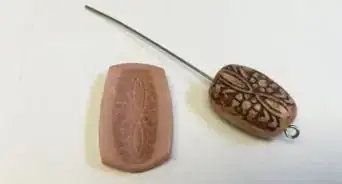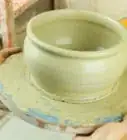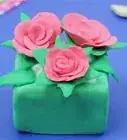This article was co-authored by Natasha Dikareva, MFA. Natasha Dikareva is a San Francisco, California based sculptor, and installation artist. With over 25 years of ceramics, sculpting, and installation experience, Natasha also teaches a ceramic sculpture workshop titled "Adventures in Clay" covering concept development, hand-building techniques, texture, and glazing techniques. Her work has been featured in solo and group exhibitions at the Beatrice Wood Center for the Arts, Abrams Claghorn Gallery, Bloomington Center for the Arts, Maria Kravetz Gallery, and the American Museum of Ceramic Art. She has taught at the University of Minnesota and the American Indian OIC School. She has been awarded the Excellence Award at the 1st World Teapot Competition, Best in Show at the 4th Clay & Glass Biennial Competition, and a Grand Prize at the American Museum of Ceramic Art. Natasha holds an MFA from the University of Minnesota and a BFA from Kiev Fine Arts College.
There are 10 references cited in this article, which can be found at the bottom of the page.
This article has been viewed 148,426 times.
Clay flowers are a popular and fun craft for people of all ages. It’s easy to make jewelry, buttons, or accessories with your clay flowers. The easiest and most popular flowers to make with polymer clay are daisies and roses, but you can add your own style to any flower that you make. Don’t be afraid to get creative and make your own type of flower!
Steps
Making Basic Daisies
-
1Hold and rub the clay in your hands to warm it up. Roll and knead the clay of your choice in your hands. You can use white clay for the entire flower or a different color for your petals and for the center of the flower.[1]
- When the clay is ready, it’ll be easy to squeeze and flatten it between your hands.
-
2Roll 1 clay ball for each petal of the daisy. Decide how many petals you want to have around your daisy, and break off equal sized pieces of clay from the main ball of clay. Then, use your hands to make balls out of the pieces of clay.[2]
- Most daisies have anywhere from 5-20 petals. If you want a daisy with a lot of petals, make 16-20 balls. If you want a daisy with space in between the petals, make 5-7 balls.
- You can roll the pieces between your hands or fingers to make the balls.
Advertisement -
3Pinch and roll the top of the clay ball to form a teardrop shape. Once you’ve made all of the balls, use your thumb and forefinger to elongate the top of each ball. Then, roll it into a cone shape to form a tear drop.[3]
- The pointed end will be behind the center of the daisy, and the thicker end will be the visible part of the petal.
-
4Press down on the larger end of the tear drop to flatten it. Use your thumb or a tool to gently flatten the thicker end. Then, carefully smooth the sides and elongate the petal by pinching and pulling slightly on the flattened part. Once it’s long enough, flatten the pointed end of the petal until it’s the same thickness as the wider end.[4]
- Make sure all of your petals are roughly the same size and shape. If one of them looks a little too small or large, simply roll it back into a ball and try again.
-
5Make another ball of clay for the center of the daisy. Pull off a piece from the main ball of clay, and roll it between your hands or fingers. Then, place the ball on a flat surface to build the flower around it.[5]
- The ball should be around the same size as the balls you made for the petals.
-
6Arrange your petals on top of the ball, radiating outward in a circle. Place the petals upside-down on the ball, with the pointed end on top of the ball. Overlap them slightly if you have a lot of petals, or just barely let them touch if you only have a few.[6]
- Try to keep the arrangement even with the petals equally distributed around the center. If you have more petals on one side, the flower will look lopsided.
-
7Turn the flower over and press down on the center to flatten it slightly. Carefully lift the flower up and place it with the petals on the back. If you’re going to bake the clay, place it on a tray or ceramic baking dish. Then, use your thumb to gently press on the center ball of the daisy to make sure it sticks to the petals.[7]
- Don’t press too hard on the center because this can cause an indentation. Make sure the circle is still slightly raised.
-
8Bake the flower for 15 minutes at 265 °F (129 °C) to harden it. If you want your clay flower to last for a long time, you can bake it in the oven. Preheat the oven to the right temperature while you work on the flower, and put it in the oven when you’ve finished it.[8]
- Remember to check the packaging for the clay to make sure you can safely put it in the oven.
- If you want to wear your flower, you can make it into a necklace or poke holes into a smaller daisy to make a button for a jacket.
Creating Clay Roses
-
1Divide a ball of clay into 7 roughly equal pieces. If you want to make a larger rose, start with a larger piece of clay. For a smaller rose, start with a smaller amount of clay. The pieces don’t have to be the same size, but should generally be about even.[9]
- You don’t need to roll the pieces into a ball since they don’t need to be perfect shapes for making the rose.
-
2Flatten one of the pieces into a rounded triangle with a thinner point. Try to find the smallest piece of clay. Then, press it until it’s in a triangular shape with rounded edges, like a guitar pick. Press on the top part of the triangle to make it slightly thinner than the bottom of the triangle.[10]
- The thin part will be folded into the “bud” of the rose, and the rest of the petals will wrap around this part. Making the bud thin will prevent the rose from becoming too bulky.
-
3Hold the triangle with the pointed side down, folding 1 side over the other. Pinch the bottom of the triangle between your thumb and forefinger, with one side under the other side. Then, roll them between your fingers slightly to form a cone-like shape at the bottom of the rose.[11]
- The top of the petal might curl slightly as you roll the bottom part. You can leave it slightly curled or flatten it if you prefer the rose to look like it hasn’t yet bloomed.
-
4Flatten the rest of the pieces into rounded triangles. Repeat the process of making rounded triangles for the other 6 petals. Remember to keep the bottoms of the petals slightly thinner than the tops to prevent the rose from becoming too bulky.[12]
- If you can, try to organize them by size from smallest to largest pieces. You’ll use the smallest pieces first and the use the 3 largest pieces to form the outer petals.
-
5Wrap the bottom of the next petal around the bud on the opposite side. Take the next largest petal and hold it so that the top of the petal is opposite the top of the folded bud. Then, wrap the bottom of the petal around the bottom of the bud to connect them.[13]
- If you want the rose to look like it is blooming, you can curl the top of the petal back slightly to make the top of the rose look more open.
-
6Attach the next 2 petals staggered between the first 2 petals. Place one petal where the bud and the 2nd petal overlap, and wrap the bottom of the petal around the bud area. Then, place the other petal on the opposite side where the petals overlap, wrapping it around the bud area on the bottom of the rose.[14]
- At this point, you should have 4 petals on your rose, and you should be able to see 3-4 places where the petals overlap.
- Keep curling the tops of the petals back if you want the rose to look like it’s blooming.
-
7Place the final 3 petals on the spots where the other petals overlap. Take the next petal and put it on a place where the petals overlap, wrapping the bottom around the buds. Then, rotate the rose slightly and add another petal to a different place where the petals overlap. Finally, add the last petal at a different place where the petals touch, and wrap the bottom around the bud, smoothing it with your hand.[15]
- Curl the outer petals outward to make the rose look like it’s in bloom.
- Shape the outer petals to bend inward slightly if you want the rose to look like it hasn’t bloomed yet.
-
8Bake the rose at 265 °F (129 °C) for 15 minutes if you want to harden the clay. If you want the rose to last for a long time, preheat the oven before you start making your flower. Place the rose on a tray or baking dish with the bud on the bottom so the top doesn’t become flattened.[16]
- Be sure to check the package for the clay before baking it in the oven. Some clays require a higher temperature for baking.
- If you don’t want to harden your clay, you don’t have to bake it.
Expert Q&A
-
QuestionHow do you make porcelain flowers?
 Natasha Dikareva, MFANatasha Dikareva is a San Francisco, California based sculptor, and installation artist. With over 25 years of ceramics, sculpting, and installation experience, Natasha also teaches a ceramic sculpture workshop titled "Adventures in Clay" covering concept development, hand-building techniques, texture, and glazing techniques. Her work has been featured in solo and group exhibitions at the Beatrice Wood Center for the Arts, Abrams Claghorn Gallery, Bloomington Center for the Arts, Maria Kravetz Gallery, and the American Museum of Ceramic Art. She has taught at the University of Minnesota and the American Indian OIC School. She has been awarded the Excellence Award at the 1st World Teapot Competition, Best in Show at the 4th Clay & Glass Biennial Competition, and a Grand Prize at the American Museum of Ceramic Art. Natasha holds an MFA from the University of Minnesota and a BFA from Kiev Fine Arts College.
Natasha Dikareva, MFANatasha Dikareva is a San Francisco, California based sculptor, and installation artist. With over 25 years of ceramics, sculpting, and installation experience, Natasha also teaches a ceramic sculpture workshop titled "Adventures in Clay" covering concept development, hand-building techniques, texture, and glazing techniques. Her work has been featured in solo and group exhibitions at the Beatrice Wood Center for the Arts, Abrams Claghorn Gallery, Bloomington Center for the Arts, Maria Kravetz Gallery, and the American Museum of Ceramic Art. She has taught at the University of Minnesota and the American Indian OIC School. She has been awarded the Excellence Award at the 1st World Teapot Competition, Best in Show at the 4th Clay & Glass Biennial Competition, and a Grand Prize at the American Museum of Ceramic Art. Natasha holds an MFA from the University of Minnesota and a BFA from Kiev Fine Arts College.
Ceramics & Sculpting Instructor Make each individual flower petal, then put them all together. Just make the petals really thin—it's very pretty when the light hits it!
Make each individual flower petal, then put them all together. Just make the petals really thin—it's very pretty when the light hits it! -
QuestionDoes it matter what type of clay I use?
 Community AnswerThere are multiple types of clay though most of them work pretty much the same, so I would say it doesn't matter.
Community AnswerThere are multiple types of clay though most of them work pretty much the same, so I would say it doesn't matter. -
QuestionCan air-dried modeling clay be placed outside after it has dried?
 Community AnswerNo, it will eventually get soggy and collapse. Use oven dried clay instead, this is waterproof.
Community AnswerNo, it will eventually get soggy and collapse. Use oven dried clay instead, this is waterproof.
Things You'll Need
- Polymer clay
- Baking tray or ceramic baking dish
- Oven
References
- ↑ https://youtu.be/QmCHoCO1jwc?t=15
- ↑ https://youtu.be/dDd74_I761I?t=12
- ↑ https://youtu.be/dDd74_I761I?t=14
- ↑ https://youtu.be/dDd74_I761I?t=24
- ↑ https://youtu.be/QmCHoCO1jwc?t=63
- ↑ https://youtu.be/QmCHoCO1jwc?t=65
- ↑ https://youtu.be/QmCHoCO1jwc?t=79
- ↑ https://youtu.be/dDd74_I761I?t=71
- ↑ http://www.jaedworks.com/clayspot/techniques/roses.html
- ↑ http://www.jaedworks.com/clayspot/techniques/roses.html
- ↑ http://www.jaedworks.com/clayspot/techniques/roses.html
- ↑ https://youtu.be/VicdzJ9oeDI?t=27
- ↑ http://www.jaedworks.com/clayspot/techniques/roses.html
- ↑ http://www.jaedworks.com/clayspot/techniques/roses.html
- ↑ http://www.jaedworks.com/clayspot/techniques/roses.html
- ↑ https://youtu.be/dDd74_I761I?t=71
About This Article
To make flowers with clay, start by forming small balls for the petals. Then, elongate one end of each ball so you have a teardrop shape, and flatten out the other end. Next, make another ball for the center of the flower before placing the petals upside down with the pointed ends on top of the ball. Once the petals are in place, turn the flower over and push down gently on the center to attach the ball to the petals. Finish by baking it at 260 degrees Fahrenheit for 15 minutes. For tips on how to make clay roses, keep reading!


















































